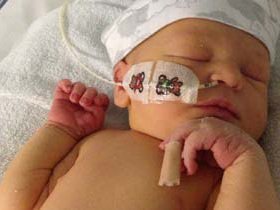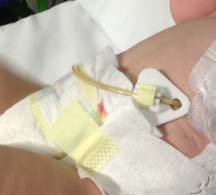If your baby or child is unable to eat and drink all he or she needs to grow and develop, he or she may need a feeding device. All or some of your child’s nutrition, and water and medicines if needed, can be given through a tube or button.
This is often called tube feeding. It is different from oral feeding, which is by mouth. Your child’s dietitian can discuss this with you in more detail.
Types of feeding devices
There are two main types of feeding devices.
Nasogastric tubes

Nasogastric tubes are normally for short-term use. They are long, thin tubes that are placed through the nostril, down the throat and into the stomach. The feeds are given through the tube to get to the stomach.
Most tubes need replacing about once a month – or more often if they are dislodged or pulled out. After training, some parents and carers choose to replace the nasogastric tubes themselves.
Occasionally, nasojejunal tubes are used. These are long, thin tubes that are placed through the nostril, down the throat and into the small intestine (just past the stomach).
Gastrostomy

If your child needs tube feeding on a long-term basis, it may be better to consider a gastrostomy. In this procedure, a small hole (called a stoma) is made through the tummy’s skin and into the stomach.
Feeds are given through a feeding device – there are two types. These have different advantages and disadvantages. Your doctor will discuss these with you before a decision is made.
- A gastrostomy tube (or a PEG) is a long tube that fits in the stoma and is held in place with a soft plastic disc. The gastrostomy tube can stay in for years if needed and does not become easily dislodged.
- A gastrostomy button may otherwise be used – this is a smaller, neater devices that is held in place in the stoma by a water-filled balloon. Gastronomy buttons generally need to be replaced every few months.
Types of feeds
There are two ways to feed your child using a nasogastric tube or gastrostomy: by bolus or by pump. You may need to use both methods at different times of the day.
Bolus feeds are done at regular times of the day. A syringe is attached to the feeding tube or button. The feeds flow by gravity into your child’s stomach, for 15–20 minutes each time.
Pump feeds are done for longer periods of time and at a slower rate. An electric pump is attached to the feeding tube or button, and the right amount of feed is slowly given over the set time – this may be overnight.
Effect on appetite
Many children start using feeding devices because their appetite is already reduced. Some children need continuous pump feeds because of excessive vomiting (being sick). The tube feeding will make sure they have the nutrition that they need to develop and grow.
Speak with your dietitian if you are concerned. Your dietitian may be able to change the feeding regimen – when and how your child feeds – so that he or she feels more hungry at mealtimes and is more likely to eat.
Oral feeding with tube feeding
Remember it is important that eating skills that have been learnt are not forgotten. Keep some oral feeding going if possible and continue to encourage variety, even if it is just with small tastes.
Tube feeding can be a very positive step towards making sure your child gets the nutrition and fluids he or she needs to stay healthy. It can be reassuring to know that there is no need to worry if your child does not eat anything.
However, it is very important that your child keeps and develops his or her feeding skills wherever possible. Remember that eating is generally an enjoyable pleasure and is a chance for a child to socialise and communicate, as well as develop skills.
Babies
Your baby can still breastfeed, bottle feed and wean while being tube fed. If you find a dummy (pacifier) helpful, offer this – it can be dipped in milk. You can also give small amounts of milk from a breast, bottle or feeding cup. Doing this at the time of a tube feed helps your child to associate sucking with a feeling of fullness.
All children
If possible, tube feed your child at meal times to keep a normal routine. Try not to be too busy or distracted, and enjoy the time together.
You can help your child associate food with a nice feeling of satisfaction, even if it is just by sight, smell and touch. If your child takes even small amounts or tastes of food, this will help to accept tastes and textures. This will also encourage your child to accept food later on.
Tube feeding after a kidney transplant
After a kidney transplant, your child may feel more hungry. You may be able to slowly reduce the tube feeding, which can also encourage eating. Speak with your dietitian or doctor before doing this. Ask whether it is okay for your child to have a period of slower weight gain while they are gaining their appetite for eating.
Feeding tubes are not ‘forever’. The majority of children take enough food and drink for their needs within a year of having a kidney transplant.